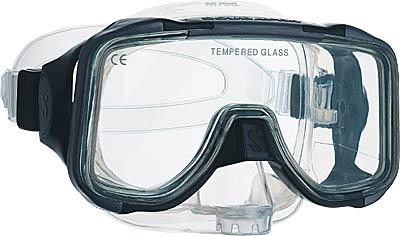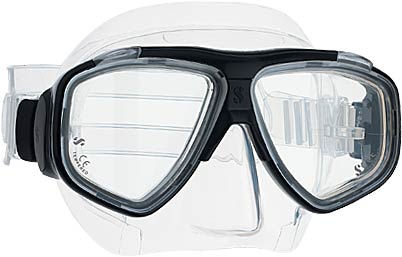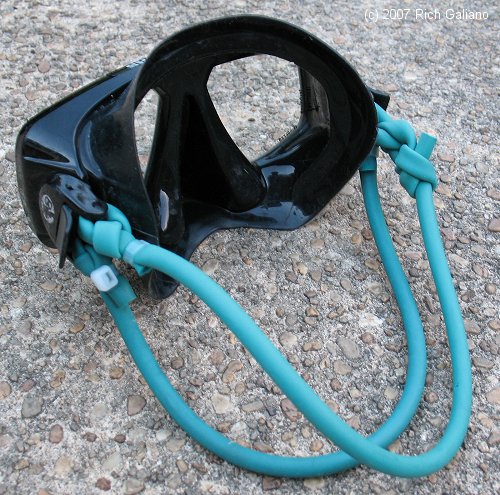Mask

Masks come in hundreds of models and designs. Options include one to six windows, purge valves, color tinting, anti-fog coatings, and whatever else the corporate marketing guys can think up.
A mask's purpose is to let you see in the water. It is surprising just how narrow your field of view in a mask actually is, although you get used to it. Generally, the closer the main windows are to your eyes, the wider your field of view, and this is good. Side windows are supposed to increase your field of view, but they also move the main windows away from your face, and at any rate, you can easily turn your head to get the same effect. A few masks also have bottom windows, which are useful for inspecting yourself or your gauges.

Purge valves are supposed to make it easier to clear water from your mask. They also add cost, bulk, a new failure point for leakage, and can be uncomfortable if not positioned properly. Tinting, to restore a natural color balance, is useful only in the clear bright waters of the tropics, and should be avoided - carry a light instead. The best frame and skirt colors are clear ( least claustrophobic ) and black ( for photographers - black admits the least outside light. ) Other colors are distracting.
Divers have two options for vision correction underwater. The first is to wear contacts under your mask. I would strongly recommend against this - just think for a moment about what sorts of problems you can have with a contact lens, and how it would be impossible to do anything about it in the water. Not to mention what could happen if your mask flooded. The much better option is to get corrective lenses for your mask. Considering that water is not perfectly clear anyway, most people will probably find that generic lenses in standard diopter strengths are adequate, rather than expensive custom prescription lenses. With many masks, it is a simple matter to install and remove these lenses yourself.
Mask fogging is especially a problem in cold waters. The best defogger I have seen is a dilute solution of baby shampoo. I've never seen a test that proved conclusively that any of the expensive drops you can buy work any better than spit, and I'd rather get my own spit in my eyes than some chemical concoction. When your mask fogs up anyway, just let a little water in and swish it around. Always wash the inside of a new mask with non-grit toothpaste to rid it of fog-inducing manufacturing residues. You may have to do this several times.
When buying a mask, it is important to actually try it on. Go to a dive shop, and try them all. Find one that fits your own face, sealing up so that you can inhale and it and it will hang on briefly by itself. Also, make sure it has enough clearance to comfortably fit the bridge of your nose, and that you can easily reach your nose with your fingers to clear your ears. Most single-window masks are only suited for people with small noses. My own preference is for a simple and inexpensive two-window mask, with no purge valve or other gimmicks.
Finally, masks wear out. When the silicone skirt on a mask tears, it is finished. For this reason, it is a good idea to have and carry both a spare strap and a spare mask in your kit.
There is some debate over whether you should wear your mask strap inside or outside of your hood. 'Inside' proponents argue that this way it cannot be knocked off. However, nor can it be adjusted or tightened when the strap is buried beneath the hood. I have never had a mask knocked off my face in the water, and do not consider this to be a major concern. The only thing that is at all likely to knock a mask off in the water is another diver's fin, and you simply should not dive with people who are that clumsy and inattentive ( for more reasons than just this ! ) So - wear your mask strap on the outside where you can adjust it, and stay away from idiots. If the strap breaks underwater, the whole issue is moot anyway.
A Better Mask Strap

One day I was all geared-up on the boat and just putting on my mask when the strap broke. Reaching down into my box, I pulled out the first thing that looked like it might do the job - a piece of surgical tubing. I threaded it through the buckles, and tied some quick knots, and within minutes I was in the water. Almost immediately, I realized that this actually works better than a standard flat strap - the round tubing is much easier to put on, and once you get the length right, there is no need to adjust it, ever. At home, I fiddled with the length a little and made the assembly permanent with some wire ties.
Realizing there was room for a second loop, I added that as well, resulting in redundant mask straps! I have seen acres of debate about what to do when your mask strap breaks - wear it inside your hood, carry a second mask ... this solves all those problems. When you consider just how critical your mask is, and how we all like to have redundant everything, it is a wonder that no one has come up with this before ( hello, DIR people ? ) Of course, the buckle could still break, but I have never seen that happen, and I'm sure with a little thought I could come up with something that couldn't break, like a piece of stainless steel wire in place of the plastic buckle pin.
And when you finally do break one of these straps, it can be repaired instantly on the spot if you simply carry a length of surgical tubing and some wire ties in your tool kit, as every diver should anyway. In fact, with the same materials, you could make quick repairs to fin straps, knife straps, wrist straps, pole spears, gauge holders, regulators, and anything else that requires a bit of stretchy stuff. Since, as far as I know, I seem to have invented this, I will call it a "Jersey Mask Strap."
DIR
Small and simple is recommended. Like I said.
